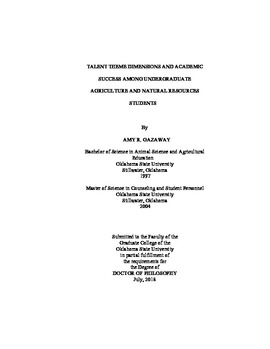| dc.contributor.advisor | Baker, Marshall | |
| dc.contributor.author | Gazaway, Amy R. | |
| dc.date.accessioned | 2019-03-22T18:57:15Z | |
| dc.date.available | 2019-03-22T18:57:15Z | |
| dc.date.issued | 2018-07 | |
| dc.identifier.uri | https://hdl.handle.net/11244/317675 | |
| dc.description.abstract | Strengths-based education initiatives have been implemented at higher education institutions world-wide as efforts to enhance student retention and degree completion. The Oklahoma State University (OSU) College of Agricultural Sciences and Natural Resources (CASNR) joined the institutions utilizing strengths identification and development practices during the fall 2008 semester. The purpose of this study was to explore the relationship between implementation of strengths initiatives by CASNR and college student success. The study was guided by five research questions: (1) Describe the pre-college and collegiate academic profile of students who matriculated with a major in CASNR and who graduated within the six-year graduation time-frame. (2) Describe the talent profile of students who matriculated with a major in CASNR and who graduated within the six-year graduation time-frame, as based on talents identified by the Clifton StrengthsFinder�. (3)What differences exist in CASNR students' specified college student success factors between dominant talent theme dimension groups? (4) What differences in first-year retention rates and six-year graduation rates exist between the classes of CASNR students preceding implementation of strengths initiatives in the AG 1011 freshmen seminar course and the classes after implementation? (5) Do the college success outcome variables predict student classification into talent theme dimension groups? Data were analyzed using descriptive statistics, ANOVA, ANCOVA, independent measures t-tests, and discriminant analysis procedures. It was concluded that academic and talent profiles of CASNR students who experienced the strengths identification and development interventions aligned with profiles of the overall college student population. No significant differences were found in college student success factors between talent theme dimension groups, and no significant difference was found in retention or graduation rates between pre-intervention and post-intervention populations. College student success factors showed no predictive value in distributing theme dimension groups. It was recommended that further study be conducted to evaluate theme dimension group differences and predictive value by CASNR majors and in students' freshmen, sophomore, and junior years and at graduation. It was also recommended that strengths development be integrated into other student experiences and that other assessments be explored to identify student talents. | |
| dc.format | application/pdf | |
| dc.language | en_US | |
| dc.rights | Copyright is held by the author who has granted the Oklahoma State University Library the non-exclusive right to share this material in its institutional repository. Contact Digital Library Services at lib-dls@okstate.edu or 405-744-9161 for the permission policy on the use, reproduction or distribution of this material. | |
| dc.title | Talent theme dimensions and academic success among undergraduate agriculture and natural resources students | |
| dc.contributor.committeeMember | Cartmell, Dwayne | |
| dc.contributor.committeeMember | Sitton, Shelly | |
| dc.contributor.committeeMember | Weeks, Penny | |
| dc.contributor.committeeMember | VanOverbeke, Deb | |
| osu.filename | Gazaway_okstate_0664D_15897.pdf | |
| osu.accesstype | Open Access | |
| dc.type.genre | Dissertation | |
| dc.type.material | Text | |
| thesis.degree.discipline | Agricultural Education | |
| thesis.degree.grantor | Oklahoma State University | |
